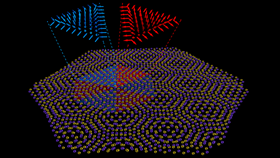 Illustration of merons in a twisted bilayer of 2D materials. Image: Daniel Bennett.
Illustration of merons in a twisted bilayer of 2D materials. Image: Daniel Bennett.British and Belgian researchers have discovered a novel topological phase in a two-dimensional system, which could be used as a new platform for exploring topological physics in nanoscale devices.
Two-dimensional (2D) materials such as graphene have served as a playground for the experimental discovery and theoretical understanding of a wide range of phenomena in physics and materials science. Beyond graphene, there is a large number of other 2D materials, all with different physical properties, which show promise for potential applications in nanotechnology. A wide range of functionality can be achieved by simply combining different 2D materials in a stack.
Scientists recently discovered that in 2D materials such as hexagonal boron nitride (hBN), which are less symmetrical than graphene, ferroelectricity can occur when one layer in a stack slides over another and breaks a symmetry. Ferroelectricity is the switching of a material's electric dipole moment with an electric field, which is a useful property for information processing and memory storage.
When 2D materials in a stack are twisted with respect to one another, they form a beautiful interference pattern known as a moiré superlattice, which can radically change their physical properties. Twisting hBN and similar 2D materials causes the different stacking regions to become polarized, leading to a regular network of polar domains, which have also been shown to lead to ferroelectricity.
In a paper in Nature Communications, researchers from the University of Cambridge’s Cavendish Laboratory, UK, and the University of Liège, Belgium, have now discovered that there is more to these polar domains than originally thought: they are inherently topological and form objects known as merons and antimerons.
“The polarization in twisted systems points in the out-of-plane direction, that is to say perpendicular to the layers,” said first author Daniel Bennett, who started this project at the Cavendish Laboratory but is now based at Harvard University.
“What we found is that the symmetry-breaking caused by sliding or twisting also results in an in-plane polarization which is similar in strength to the out-of-plane polarization. The in-plane polarization forms a beautiful vector field, and its shape is determined entirely by the symmetry of the layers.”
The discovery of the in-plane polarization shows that the electrical properties of 2D twisted systems are much more complex than previously thought. More importantly, by combining both the in-plane and out-of-plane parts of the polarization, the team realised that the polarization in these twisted bilayers is topologically non-trivial.
“In each domain, the polarization field winds around by half a revolution, forming a topological object known as a meron (half a skyrmion),” explained Robert-Jan Slager, whose group at the Cavendish Laboratory was involved in the study. “Throughout the twisted layer, a robust network of merons and antimerons forms.”
“In physics, most things can be understood in terms of energy,” said Bennett. “Nature is lazy and likes to do things in the most efficient way possible, doing so by minimizing the energy of a system.”
The phase that a material will adopt is typically the one that has the lowest energy. However topological phases and topological properties are not determined by energetics, but by the various symmetries of a system. The physical properties of a system, such as its electric or magnetic fields, can form complex structures that wind or tie themselves in knots because they are forced to by symmetry.
“The energetic cost of untying these knots is very high, so these structures end up being quite robust,” said Slager. “Being able to create, destroy and control these topological objects is very appealing, for example in the field of topological quantum computing.”
In order to do this, the researchers’ future goals are to develop a better understanding of topological polarization, as well as to develop a proof-of-concept for a device in which the polar merons/antimerons they discovered can be controlled, or lead to exciting new physical phenomena.
This story is adapted from material from the University of Cambridge, with editorial changes made by Materials Today. The views expressed in this article do not necessarily represent those of Elsevier. Link to original source.